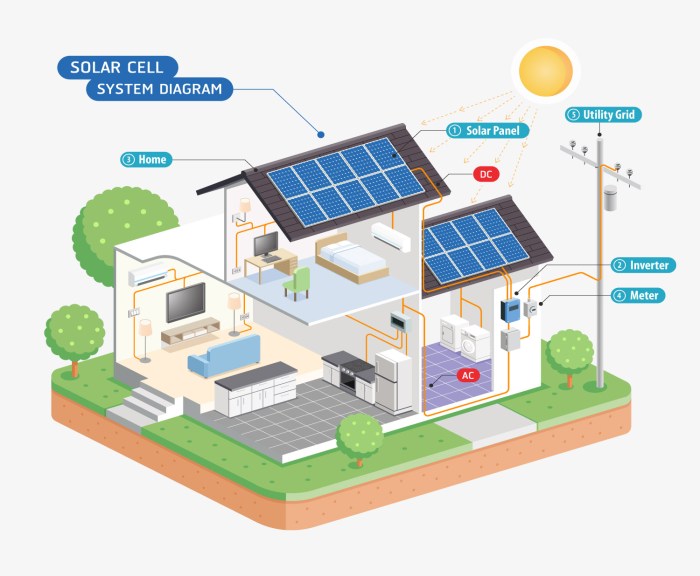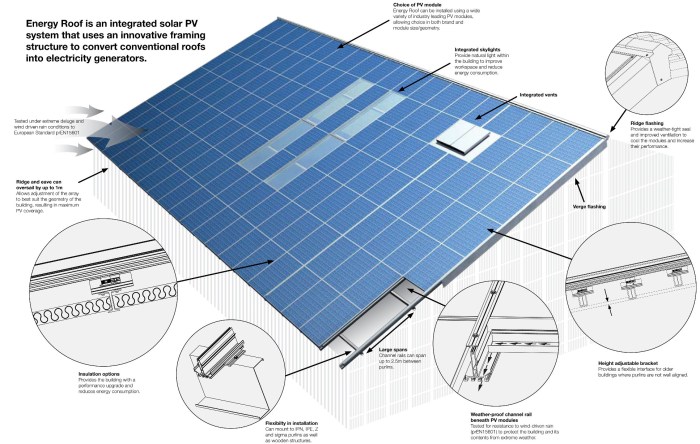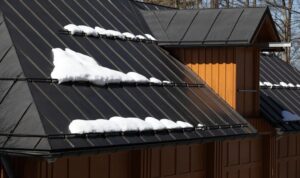Diving into the world of solar panel roofing systems, this introduction aims to provide a detailed insight into how these innovative systems work. From their integration into roofing structures to the various types available, we will explore the benefits, installation process, maintenance, environmental impact, and cost considerations of solar panel roofing systems.
Get ready to embark on a journey of sustainability and efficiency with this enlightening guide.
Overview of Solar Panel Roofing Systems

Solar panel roofing systems are innovative solutions that combine the functionality of traditional roofing materials with solar panels to generate renewable energy. These systems are designed to seamlessly integrate solar panels into the structure of a roof, providing a dual purpose of protection and energy generation.
Integration of Solar Panels into Roofing Systems
Solar panels are typically mounted on top of roofing materials such as shingles or tiles, using specialized mounting hardware to ensure a secure and weather-resistant installation. The panels are connected to an inverter, which converts the direct current (DC) electricity generated by the panels into alternating current (AC) electricity that can be used to power homes or businesses.
Benefits of Using Solar Panel Roofing Systems
- Sustainable Energy Source: Solar panel roofing systems harness the power of the sun to generate clean and renewable energy, reducing reliance on fossil fuels and lowering carbon emissions.
- Cost Savings: By generating electricity from sunlight, solar panel roofing systems can help reduce utility bills and provide long-term savings on energy costs.
- Increased Property Value: Installing solar panels can increase the value of a property, making it more attractive to potential buyers and potentially leading to a higher resale value.
- Environmental Impact: Solar panel roofing systems help reduce the environmental impact of traditional energy sources by producing clean energy and lowering greenhouse gas emissions.
Types of Solar Panel Roofing Systems
When it comes to solar panel roofing systems, there are several types to consider. Each type offers different advantages and is suitable for various architectural styles. Let's explore the different types based on efficiency, aesthetics, and cost.
Integrated Solar Tiles
Integrated solar tiles are designed to blend seamlessly with traditional roofing materials, providing a more aesthetically pleasing option. While they may be more expensive upfront, integrated solar tiles are often more efficient and can increase the overall value of the property.
Solar Shingles
Solar shingles are similar to traditional roofing shingles but come equipped with solar cells. They are easy to install and offer a sleek look to the roof. However, they may not be as efficient as traditional solar panels and can be more costly.
Solar Panels Mounted on Existing Roofs
For homeowners looking to add solar panels to an existing roof, this option involves mounting traditional solar panels on top. While this may be a more cost-effective solution, it may not be as visually appealing as integrated options. However, this type of system can still be efficient and provide significant energy savings.
Installation Process of Solar Panel Roofing Systems
When it comes to installing solar panel roofing systems, there are several key steps involved to ensure proper functionality and efficiency. From considering roof orientation and tilt to integrating wiring and inverters, each step plays a crucial role in the overall success of the installation process.
Roof Orientation, Tilt, and Shading Considerations
- Roof Orientation: The ideal orientation for solar panels is facing south in the northern hemisphere and north in the southern hemisphere to maximize sunlight exposure.
- Roof Tilt: The tilt angle of the solar panels should be adjusted according to the latitude of the installation site to optimize energy production.
- Shading: It is important to assess any potential shading issues from nearby trees, buildings, or other obstructions that could affect the efficiency of the solar panels.
Integration of Wiring and Inverters
- Wiring: Once the solar panels are mounted on the roof, the wiring needs to be carefully installed to connect the panels to each other and to the inverters.
- Inverters: Inverters play a crucial role in converting the DC electricity generated by the solar panels into usable AC electricity for your home. They are typically installed near the main electrical panel.
Maintenance and Care of Solar Panel Roofing Systems
Proper maintenance is essential to ensure the longevity and efficiency of solar panel roofing systems. By following a regular maintenance routine, you can maximize the energy output of your solar panels and prevent potential issues.
Regular Maintenance Tasks
- Inspecting the solar panels for dirt, debris, or any shading that may affect their performance.
- Cleaning the solar panels with a soft brush or cloth and mild detergent to remove dust, bird droppings, or other contaminants.
- Checking the mounting structure and frame for any signs of damage or corrosion.
Maximizing Lifespan and Efficiency
- Trimming trees or vegetation that may cast shadows on the solar panels, reducing their energy production.
- Monitoring the energy output regularly to detect any decrease in performance and address issues promptly.
- Investing in a monitoring system to track the energy production and detect any anomalies in real-time.
Troubleshooting Common Issues
- If the solar panels are not producing enough energy, check for shading, soiling, or wiring issues that may be causing the problem.
- Inspect the inverter for any error codes or malfunctions that could impact the overall system performance.
- Contact a professional solar technician if you encounter any persistent issues that you are unable to resolve on your own.
Environmental Impact of Solar Panel Roofing Systems

When it comes to environmental impact, solar panel roofing systems offer a multitude of eco-friendly benefits that contribute to a more sustainable future. These systems play a crucial role in reducing carbon footprint and promoting clean energy usage.
Eco-Friendly Benefits of Solar Panel Roofing Systems
Solar panels harness the power of the sun to generate electricity, which significantly reduces the reliance on traditional fossil fuels. By utilizing renewable energy from the sun, solar panel roofing systems help decrease harmful emissions and combat climate change.
Reduction of Carbon Footprint
The use of solar panel roofing systems leads to a substantial reduction in carbon footprint by offsetting the emissions produced from conventional energy sources. This shift towards cleaner energy sources is essential in mitigating the impact of global warming and promoting a healthier environment.
Long-Term Environmental Impact
Widespread adoption of solar panel roofing systems has the potential to make a significant impact on the environment in the long run. As more households and businesses transition to solar energy, there will be a substantial decrease in greenhouse gas emissions, leading to a cleaner and more sustainable future for generations to come.
Cost Considerations and Financial Incentives
When considering the installation of solar panel roofing systems, it is important to understand the associated costs and potential financial incentives that can make this investment more appealing.
Breakdown of Costs
Installing solar panel roofing systems involves various costs, including the purchase of solar panels, inverters, racking systems, wiring, and installation labor. The total cost will also depend on the size of the system, the type of solar panels chosen, and any additional features like battery storage.
Financial Incentives and Tax Credits
There are several financial incentives, tax credits, and rebates available to homeowners who install solar panel roofing systems. These incentives can help offset the initial costs and make solar energy more affordable. For example, the Federal Investment Tax Credit (ITC) allows homeowners to deduct a percentage of the cost of their solar system from their taxes.
Return on Investment (ROI)
Calculating the return on investment for solar panel roofing systems involves considering the initial cost of installation and the savings generated by lower energy bills over time. While the upfront costs can be significant, the long-term savings on electricity bills can result in a positive ROI.
On average, homeowners can expect to recoup their investment in solar panels within 5 to 7 years, depending on various factors.
Outcome Summary
In conclusion, solar panel roofing systems offer a promising solution for harnessing renewable energy and reducing our carbon footprint. With their eco-friendly benefits, cost-effectiveness, and long-term sustainability, these systems pave the way for a greener future. Embrace the power of solar energy and make a positive impact on the environment with solar panel roofing systems.
FAQ Insights
How do solar panel roofing systems work?
Solar panel roofing systems convert sunlight into electricity through photovoltaic cells, which are integrated into the roofing structure.
What are the common maintenance tasks for solar panel roofing systems?
Regular cleaning, checking for damage, and ensuring proper wiring connections are essential for maintaining solar panel roofing systems.
Are there any tax incentives for installing solar panel roofing systems?
Yes, there are various financial incentives such as tax credits and rebates offered by the government to encourage the adoption of solar panels.






